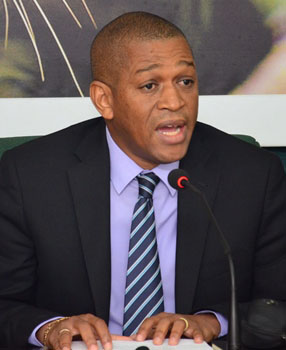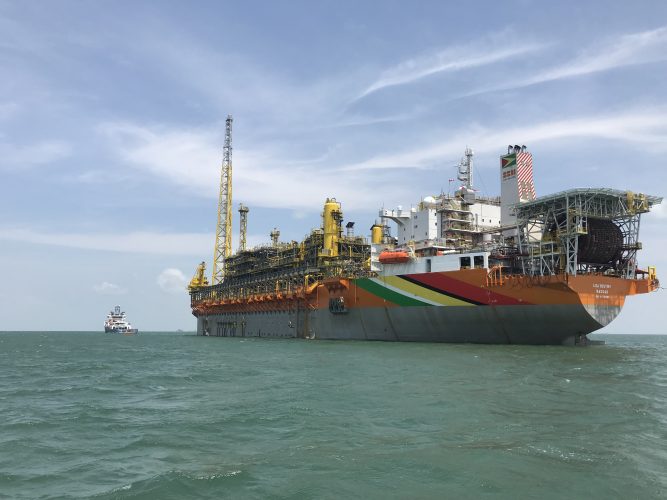An addendum to the Liza-1 Production Licence, which was never made public, was signed last year by former President David Granger and paved the way for environmental upgrades for the Liza-2 project and subsequent major improvements to the recently approved Payara licence.
An analysis was done by the Sunday Stabroek of the Liza-1 well Licence, the Addendum to cater for the Liza-2 well, the Payara Licence – both the draft proposal and final Payara Production Licence – and the three respective environmental permits.
(While there is reference to the measures covered in the three environmental permits in this article, as most formed guidelines for the licences, a separate analysis of those permits will be done.)

The review of the licences reveals an evolutionary process from Liza-1, which was signed by then Minister of Natural Resources Raphael Trotman, to the Payara draft, which was credited to the Department of Energy (DoE) under Dr Mark Bynoe and the Environmental Protection Agency (EPA) head Dr Vincent Adams, where it went from a vague and dismally poor oversight document to one with world-class environmental standards and practices. Bynoe had outlined the changes to be made last year but the document was never released to the public.
However, when the final Payara Licence was signed recently, it omitted recommendations for further improvements, such as a 48-hour start-up flaring timeframe, that produced water be reinjected into the reservoirs rather than dumped into the ocean and it also kept the capping stack time at five days instead of the proposed three days.
By the time the Payara Licence went for review under President Irfaan Ali’s government which sanctioned a re-examination of the licence led by Canadian Queen’s Counsel and former Alberta Premier Alison Redford, all of the current terms were encompassed but with stricter language and penalties on environmental commitments such as flaring and dumping of produced water, decommissioning and cost auditing.

It is unclear what Redford’s review findings were and the recommendations made. Her terms of reference have also not been made public, despite requests by this newspaper for it. Her report was also not made public.
Revise and update
Noted also is that for the Liza-2 well, which is expected to begin producing oil in mid-2022, a broad area catered for the company to “Revise and update the Environmental and Socioeconomic Management Plan including the Waste Management Plan, the Decommissioning Plan and the Oil Spill Response Plan”.
One month after its completion by ExxonMobil, the Liza-2 plan requires that the company submit a copy of its Operations Integrity Management Plan (OIMP), a system used by the company to address all aspects of its business that can impact personnel and process safety, security, health and environmental performance.
For Payara, which is expected to begin producing oil in 2024, ExxonMobil would now set aside to government a five-year total of US$2M or US$400,000 per annum, as part of cost oil commitments, so that this country could independently carry out safety and compliance audits. It is an extension of the OIM measures set out before under Liza-2. It would mean that the monies would be taken out of government’s profit as it has to stand its respective share of cost oil.
New in the draft for Payara, which is also contained in the final licence, is that operating and development costs must be submitted to Government of Guyana within 90 days of the signing of the licence. It means that government would be in a position to analyze and gauge what cost recovery for the project would be by the time the actual cost recovery sums are submitted.
Payara also allows ExxonMobil to carry out unit development petroleum operations in the Liza licence areas so that recovery is more effective and manageable.
Capping stack
The Liza-1 licence, under which historic oil production began in December last year, has scanty and extremely vague technical and environmental guidelines, with lots of decisions to be taken at the discretion of the responsible minister. The Liza-2 development upgrade sought to put some definitive deliverables for the US oil giant, such as catering for having the necessary seal (Capping Stack) for the Blow out Preventer (BOP) available at the location within at least five days after a spill.
Online oil and gas resource publication for the Society of Petroleum Engineers ‘The Way Ahead’ explains that a BOP “is a safety device meant to prevent a blowout from occurring—that is, to prevent an uncontrolled flow of liquids and gases from reaching the surface”. The BOP is always present when drilling, and any time the drilling team suspects fluids and/or gases could be released from the wellbore in an uncontrolled manner, it can activate the BOP to prevent such an outcome. It adds that a capping stack is not needed when drilling. “It is the centerpiece of a containment system kept in readiness at an onshore location. It is only deployed after the BOP has failed to serve its purpose and a blowout has occurred. A “capping stack” is a piece of equipment that is placed over the blown-out well as a “cap.” Its purpose is to stop or redirect the flow of hydrocarbons and to buy time for engineers to permanently seal the well. It is massive and can weigh as much as 50 to 100 tons, presenting logistical challenges in quickly transporting it to the emergency occurring at the blown-out offshore well,” the publication explains.
“Before the capping stack arrives, a remotely operated vehicle (ROV) inspects the seabed site and engineers zero in on precisely what equipment is needed. Then debris is removed and the wellhead is prepared. After the equipment arrives, the capping stack is carefully maneuvered into place over the wellhead. Once fully operational, the capping stack provides a dual barrier for containment—a BOP ram, plus a containment cap. The stack’s valves can be closed to cap the well (“cap only”) or, if necessary, the flow can be redirected to surface vessels through flexible pipes and risers (“cap and flow”),” it adds.
While there was no such provision for Liza-1, ExxonMobil proposed a 21-day delivery period for a capping stack in their Liza-2 development plan, but this was rejected and a counterproposal of five days was subsequently agreed to. The Liza-2 document also lists a number of provisions that must be submitted by the company to assure that it would meet the five-day stipulated period.
For Payara, the Department of Energy and the EPA had sought to further reduce the deployment time to three days, citing possible oil spill damage that could occur in five days, but under the current licence the period remains at five days. This newspaper understands that the reasoning behind the continued five-day period was to provide for transport from its storage facility in Trinidad and Tobago to the Stabroek Block offshore location.
Important to note is that Guyana does not have the requisite port or other facilities for the storage of such huge and heavy subsea machinery. Currently, the nearest access to a capping stack is Brazil.
Flaring
On the issue of flaring, both the licences for Liza-1 and Liza-2 note that routine flaring was prohibited but they did not limit the start-up flaring period permitted, neither were fines implemented.
The Liza-1 licence stated that “all facilities shall be planned and constructed so as to avoid any natural gas flaring or venting under normal operating conditions and that the licencee shall not flare or vent unless authorized in writing by the minister under specified conditions.” Venting is the release of the natural gas into the environment as is while flaring is the burning of the gas where it is converted into carbon dioxide. Both are damaging to the environment but venting is worse because of the likelihood of its methane content. The Liza-2 document, on the other hand, eliminates the use of the word venting altogether. It asks the company to “analyse and quantify the impact, magnitude and severity for Greenhouse gas emission, providing evidence of a Greenhouse gas reduction/minimization plan, together with how Greenhouse gas emissions have been rated, discussed and addressed within the overall project design,” and “detail a gas flaring minimization plan.”
The Payara draft licence proposal also cites the prohibition of routine flaring and wanted to limit the environmentally hazardous practice to United States standards where the company would be given 48 hours. However, the current licence gives the company 60 days for flaring.
It says too that flaring is only permissible under the following conditions defined in the Licensee’s Environmental Permit: (a) Commissioning and Start-up: the Licensee shall not exceed sixty (60) days of flaring during Start-up; and (b) Special circumstances, including: 1) Emergencies; ii) Maintenance; iii) Restart, or as allowed under the Environmental Permit or approved by the Environmental Protection Agency.
In the United States, “48 cumulative hours” is given for startup or more only through “regional supervisor” approval, according to its environmental laws.
Too much gas
Texas oil and gas regulator Wayne Christian has said that there’s too much gas being burned off out of convenience rather than necessity, and he’s concerned about the “frequency and ease” with which companies are being allowed to continue with the practice.
The Payara licence gives the company 30 days or until 24th of November 2020, to submit for approval by the minister, terms of reference for a study that will meet the terms pertaining to flaring. During the study, the company must meet no less than once per month to provide updates and progress. And one month before the study is completed, the company will give the minister the study so that this country can have an input.
And should flaring be done outside of its Environmental Permit, it will be hit with fines to be calculated in a framework that will be established.
The licence says, “The licensee shall pay all fines imposed in respect of the flaring in violation of the Environmental Permit- (a) by Law, (b) by the EPA; and (c) in accordance with the terms of a framework to be established by the Minister to compensate the Government.” The fine shall be calculated by applying the Government’s profit gas and royalty percentage share for a given month to the flared volumes multiplied by the lower of the following: i) the inside FERC Henry Hub Index price as published by Platts each month, or ii) the sales price agreed for gas from the Stabroek Block, such price netted for the cost of pipeline transportation to shore per thousand standard cubic feet of gas.
From its production startup in December of last year, ExxonMobil has flared over 10.6 billion cubic feet of gas and has not from its first August 10th target told this country definitively when it will cease, only that it was working to “soon” resolve the problem.
Industry experts and environmentalists have put the monetary value of the gas flared to over US$24 million using calculations similar to those under its Greenhouse pact with Norway.
Water dumping
How produced water would be dealt with held up the environmental permit for the Payara Project as the EPA had suggested first world practices of reinjecting the water back into the wells. This issue was not present under the Liza-1 Licence but the Liza-2 licence stipulated that within 60 days of its approval, the licensee was required to supplement the Environmental Impact Assessment with “full descriptions of the alternatives that have been considered for the treatment or disposal of produced water”.
Of note is that the Permit for Liza-2 stated that “Produced water from the reservoir shall be treated onboard the FPSO (Floating, Production, Storage and Offloading platform) to an acceptable specification prior to discharging. The oil content specification of produced water to be discharged shall not exceed 42ml/L on a daily basis or 20mg/L on a monthly average. If the oil content of produced water is observed to exceed these limits, the produced water shall be routed to an appropriate storage tank on the FPSO” for further treatment until discharge meets the specification stated.
When ExxonMobil had suggested that it wanted to continue, like in Liza-1, to continue to treat and dump water from the oil reservoirs into the ocean, it had been asked by the Environmental Protection Agency and Department of Energy to provide a study on effects of the practice to both marine and human life.
According to ExxonMobil’s local affiliate EEPGL’s liquid production profile, at peak production there is estimated to be equal volumes of water and oil during production.
The company had cited costs for treating the produced water, with its current Country Manager Alistair Routledge saying that it would be up to government to balance costs.
According to the calculations, since 42 gallons of crude makes up a barrel, it would mean that for every million barrels of water discharged, 42 barrels of oil will be dumped into the ocean.
To date, ExxonMobil has had 18 discoveries and has not appraised all of those but gives its estimated recoverables at over 8 billion barrels of oil. On that estimation, it would mean that at least 8 billion barrels of water will be dumped into the ocean and from that concentration, according to the 42mg per litre for every million barrels dumped, this country would see over 336,000 barrels of oil in its ocean.
And if the 336,000 barrels of oil are sold, even at US$40 per barrel, it would be valued in excess of US$13.4M. It is unclear what the cost is to retrofit the company’s equipment to allow for round-the-clock reinjection of water.
The Payara Licence was nonetheless granted approval with the PPP/C government saying that provisions have been made for the company to undertake a study on the effects the project is going to have and it will guide how it looks at subsequent projects.
ExxonMobil must within 30 days of the environmental permit submit to the Minister and the EPA for approval of terms of reference for a study detailing “the costs, benefits and feasibility of implementing a system for the re-injection of the produced water, save and except in defined unavoidable situations, as the primary disposal methods; and the minimization of the effects of discharging produced water into the ocean in keeping with accepted international standards.” When the minister approves the terms of reference, EEPGL has 180 days to complete the final study.
The Payara Licence was signed by Minister of Natural Resources Vickram Bharrat and EEPGL and Stabroek Block partners Hess and CNOOC on September 30th.
Vice President Bharrat Jagdeo said that government thought it best to sign the agreement as it got most of the changes it wanted in line with the two documents: the environmental permit and the production licence.





